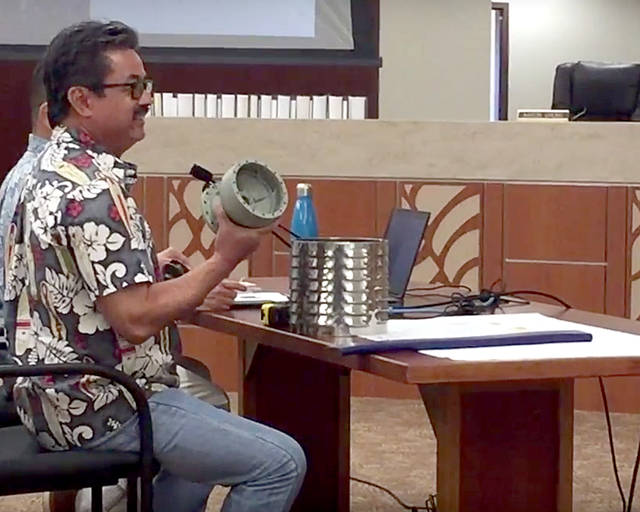KAILUA-KONA — Keith Okamoto, Hawaii County Department of Water Supply manager and chief engineer, came to Kona on Monday to offer a presentation on the area’s water emergency to the Hawaii County Council’s Agriculture, Water and Energy Sustainability Committee. ADVERTISING
KAILUA-KONA — Keith Okamoto, Hawaii County Department of Water Supply manager and chief engineer, came to Kona on Monday to offer a presentation on the area’s water emergency to the Hawaii County Council’s Agriculture, Water and Energy Sustainability Committee.
He presented at the behest of Council members Dru Mamo Kanuha and Karen Eoff, whose 7th and 8th Districts, respectively, have been impacted by several inoperable deepwells within the North Kona water system since January.
Okamoto’s presentation focused primarily on contingencies to avoid a repeat of a situation that’s led North Kona to the brink of water disruptions to the region’s more than 11,000 accounts.
For most of the year, four of the region’s 13 wells have been offline. For roughly a week in late June and early July, that number jumped to five when the recently repaired Keahuolu Deepwell malfunctioned, which led to stricter water restrictions during that time.
“With our experience at Keahuolu, we feel fairly confident that if we implement similar contingency plans, even step it up a few notches, we’ll be able to maintain service to the community,” Okamoto said when discussing what happens if another well goes down.
Contingencies
A 25 percent water usage reduction issued in January remains in effect, and will remain even after the Waiaha Deepwell comes back online on July 31. Repairs at three other wells are set for completion in late October, November and December, respectively.
Okamoto said the base restriction is likely to be rolled back once three of the four wells are fixed, meaning around Thanksgiving, although he expressed optimism those wells may be repaired ahead of schedule.
DWS stopped service to temporary accounts and special irrigation-only accounts during the worst of the shortage.
The department is also in the process of installing flow restriction devices on accounts engaged in habitual over use of water, setting the offender line at 10 times the amount of water those accounts are supposed to be allotted.
Okamoto said in a worst-case scenario, water could be hauled from South Kona by truck, but that’s not a particularly feasible solution as each truck has a capacity of only 4,000 gallons. The region pumps roughly 12 million gallons per day.
DWS is engaged with Hawaii County Civil Defense and the Hawaii Emergency Management Agency to scour departments across the nation for spare pumps and motors that meet individual deepwell specifications in North Kona. Motors are more interchangeable, Okamoto said, but pumps are essentially unique to the wells in which they’re installed.
In the meantime, DWS has opened bids for three sets of pumps and motors including one for the Honokohau Deepwell, which is a crucial water source for North Kona. The process will now begin before selected wells fall out of commission to cut down manufacturing and installation times.
DWS doesn’t have the budget to back up all water sources, which is why few spare parts are on hand. Storing spare equipment is expensive and warranties last only one year.
The department hopes for a lifespan of five to seven years on freshly installed equipment, but it can falter more quickly. Okamoto explained that two of the four North Kona wells that remain inoperable went down in 2016, about six months after parts were replaced.
DWS didn’t move to repair them immediately out of what Okamoto called fiscal responsibility, as they were covered under warranty. Once another two wells went offline, however, the social cost of waiting outweighed the financial cost of moving forward.
“We’re actually going to have a professional services contract come that will help us review … to see if there’s something that we’re missing,” Okamoto said. “Six months is not acceptable.”
Finally, DWS plans to conduct an overall system evaluation to identify weak points and will also employ well construction standards. Those standards will lean toward a shift from one higher-capacity pump to two medium-capacity pumps, which handle a similar capacity but tend to last longer.
Common questions
One question Kanuha said he’s heard often involves the regulatory and financial relationship between Hawaii County and DWS, which gets at accountability for the water emergency.
DWS does work with the county’s Planning and Public Works departments when necessary, but is supported financially mostly by its own revenue with occasional grants for capital improvement projects.
“Basically, the situation we’re in is all on us,” Okamoto said. “It wasn’t through any issue with the administration or the County Council, it really was all on us.”
Eoff said a question she’s fielded frequently involves why golf courses and resorts remain so green despite irrigation restrictions.
Okamoto said most golf courses don’t use potable water from DWS for irrigation, adding many businesses have helped during times of particular strain.
“I would just like to emphasize that the most important thing is that we are going to make plans for the future so that we don’t have any dire emergencies,” Eoff said. “You realize how much water you can conserve if you try. It’s not that hard.”
Finally, Kanuha probed future water availability as Kona continues to expand.
“This is kind of a wake-up call to see what it can handle, how much water is out there and what we can actually use to make sure our population is taken care of,” Kanuha said.
Okamoto said the sustainability yield at the Keauhou aquifer is 30 million gallons per day and, at least for now, Kona’s water sources are sufficient as long as wells continue to function.
“For decades down the road, we’re still in a safe area,” Okamoto said. “We’re very comfortable with the amount of development (expected) for the foreseeable future.”



